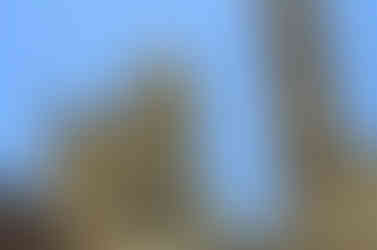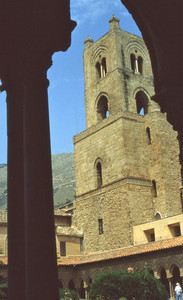BOX 147: Sicily, Part 2.
- Joe Milicia
- Nov 1, 2021
- 6 min read
Updated: Mar 20, 2022

Just below the hill you're standing on, you can see a Greek-style temple, never completed but still standing since the 400s BC. This is what is left of Segesta, an ancient city in northwestern Sicily, where Max, Janet and I were traveling in the summer of 1983.
We had driven from Agrigento, on the south coast (see previous BOX), to Trapani and Erice at the extreme far west of the island. I'm now baffled by the fact that I seem to have taken no photos of either town, especially since Erice is on a high hill overlooking the sea; but I did record our visit to Segesta, situated amid magnificent hills, as the above photo shows. Here is a closer view of the Temple of Segesta:

The most obvious signs of its never having been finished are that it was never roofed and the columns aren't fluted. But it was still one of the more beautiful sights of our trip. Here are some closer views:

That's Max standing between two columns in the third picture. I see that I also took a couple of photos of a woman in a colorful outfit standing outside the temple--almost dramatically posing in the second photo:
A short way from the temple is the ruin of a Greek-style amphitheater. Here are two photos, looking down and looking up. (Quite a view from the seats!) I remember a man trying out the acoustics by declaiming (in Italian), "Romeo, Romeo, wherefore art thou Romeo!"


That could be Max sitting on a block of stone toward the top right, but I'm not sure. I should mention that I'd noticed other tourists, presumably Sicilian ones, picking a shrub or bush (about a foot in diameter) in the fields around the sites. We had parked our car in a field of grass at the top of a hill, where an elderly parking attendant had pointed where to go, and who directed us to our car when we were leaving (though we could easily have found it ourselves). I figured it was customary to give him a small tip, so I did--at which point he asked us to wait a minute as he went off. He came back with one of those shrubs and handed it to us through the window. Apparently I had given him a good tip. It was immediately clear from the scent what the shrub was: wild oregano. We thanked him, and I ended up keeping the fragrant herb on the back shelf of the car, where it had dried nicely by the time we turned in the car when we caught a ferry to Greece. I'm not sure how I managed to keep the oregano in a plastic bag as we traveled to Greece and England and back to the States, or how I got it through customs. (I must have pulled the leaves off the stems and put them in a little bag or jar by that point.) But I did, and for over a year it kept all its fragrance as I cooked with it.
Our next stop was the Sicilian capital, Palermo. Because all the other Sicilian cities we'd visited were fairly modest in size and easily navigable, I wasn't prepared for what felt like a Chicago-size city. It took a lot of navigating and stopping to ask pedestrians before we found our way to the central district where our guidebook had recommended hotels. But we managed, and here is the first photo I took in Palermo: it's the Opera House, though nothing was playing at the time:

I see that the Pretoria Fountain, from the 1500s, which fills the piazza of the same name, impressed me enough to take three photos of it (the third later in the day):

Palermo had a street market on certain days that stretched along several blocks of narrow streets. Here is one small portion of it:

There were big displays of olives and cheeses as well as fruits and vegetables. I remember that we bought some totally unfamiliar fruit, the size and color of apricots but very different, and took them back to our hotel to try; I think they were medlars.
We visited the San Cataldo Church with its Arab-Norman design features:

. . . and Palermo's Cathedral:
But the most spectacular church we visited was the Cathedral of Monreale, on a slope on the outskirts of Palermo. Built between 1172 and 1267, the church's architecture is a blend of Norman, Byzantine and Arab elements. (Sicily was conquered by a great variety of invaders.) My slides offer only a few glimpses of parts of the Cathedral:

Here are a few views of the interior:

And here is the cloister. One shot shows the tower (which looks as Norman as the arches look Moorish) as seen from the cloister:
And these are all my photos of Sicily. I now wonder why I didn't take many more, but as I've mentioned in previous posts, the cost of rolls of slide film in those days, matched against my budget, was probably a major reason. In any case, we drove from Palermo eastward along the north coast past Cefalu and around to Messina, where we arrived in late afternoon and decided to stay overnight before catching the ferry back to the mainland. By this time I had worked up my courage to try to call some of the Milicias in the phone book to see if we were cousins and if they would like to meet up with me that evening. Three of the eight listings had "Prof" in front of their name so I decided to try them first--it could be a conversational ice-breaker, though I knew that in Italy a professore could be a high-school as well as a college instructor. So with my very weak Italian I tried calling from a payphone while Max and Janet went off on their own. The first person I tried had moved to Rome, I was told. The second person, a young woman, said, "This is a joke [uno scherzo], right?" but I got her to stay on the line long enough for her to tell me that her father was out of town, and to write down my hotel name in case he returned early. No luck with the third "prof" either. Max or Janet had the good idea to have the bilingual desk clerk at our hotel try other listings--and this resulted in their reaching a Ronaldo Milicia, who turned out to be a professore too (was there a teaching gene I'd inherited?), and he would meet me in the hotel lobby in an hour. So my friends went off to dinner and I met Ronaldo, who was about my age and had red hair and blue eyes. He spoke no English but some French, which I could converse in better than Italian. So we went for a long walk around Messina, during which we established that we were not close relations, but he was sure we were distant cousins. (The Milicias were a "Norman baronial family," he said, and that heritage could account for our light hair and blue eyes, though I'd always thought I got them from my mother's side.) He urged me to call him if I ever returned to Sicily.
That was a great experience, and the next morning my friends and I were packing up to catch the ferry back to Reggio di Calabria when I got a phone call from the deskman: he had gotten a call from a Giuseppe Milicia, who had returned from his country house and was urging me to stay at the hotel until he could meet me. Max and Janet generously volunteered to take the ferry as pedestrian passengers and meet me at a museum in Reggio that afternoon, so I waited for Giuseppe, who turned out to be about 60 with white hair and blue eyes, and spoke English quite well: in fact, he had been an English teacher, and had lived in Cleveland for a while, though again, we were not close cousins. (I knew there existed another Milicia family in Cleveland unrelated to us.) He didn't know Ronaldo either, though he too assumed we were all distant cousins. Giuseppe invited me to his nearby apartment, where I met his daughter, around 20, who was dark-haired and olive-skinned with big dark eyes that looked Greek to me, and who still seemed amused by my quest. Again, it was richly rewarding to have made this contact, and Giuseppe too urged me to call him if I ever returned, and even to stay with him and his family.
After returning to the States I found out from my uncles that my family was not from Messina after all but from a little town called San Pier Niceto, north over the mountains from Messina, not too far from Cefalu. But after my meeting with Giuseppe, I took the ferry to meet up with my friends. I'll save the story of what I encountered in Reggio until the next post, since this has already been by far the longest anecdote without photos I've posted since I began this blog.



































Comments